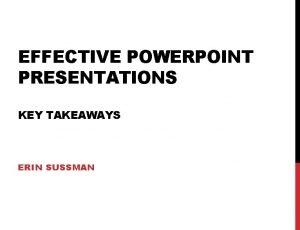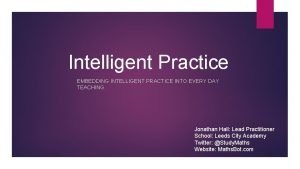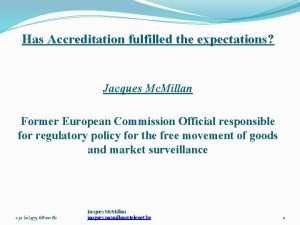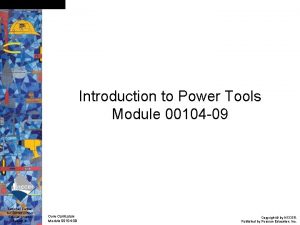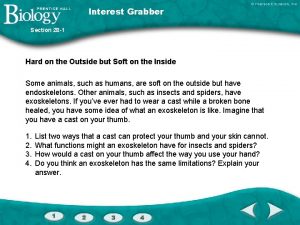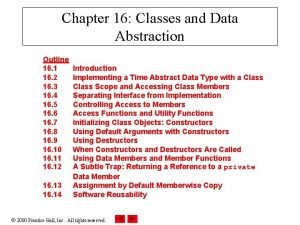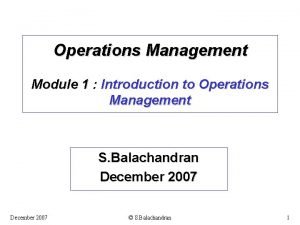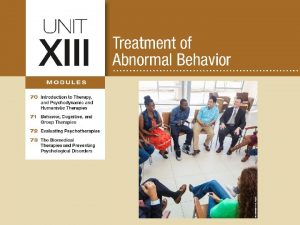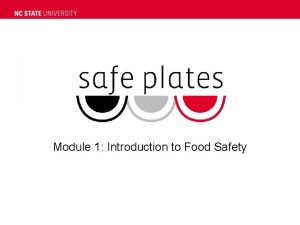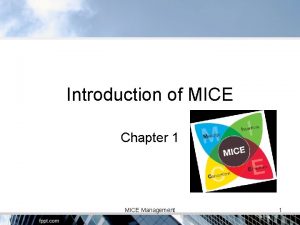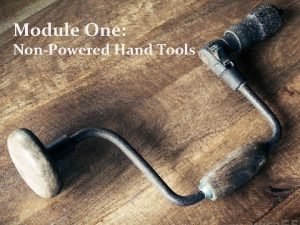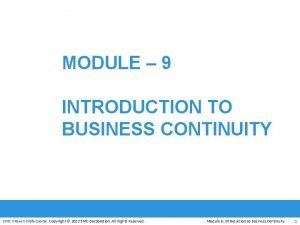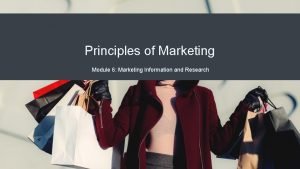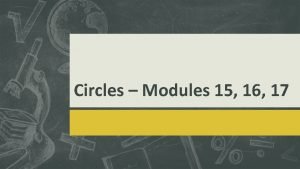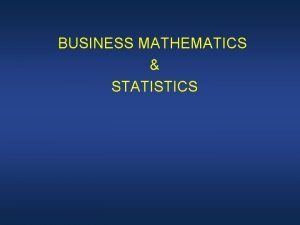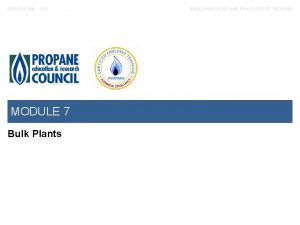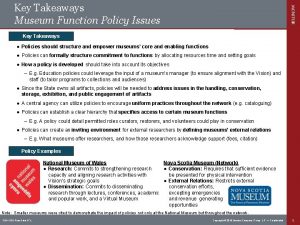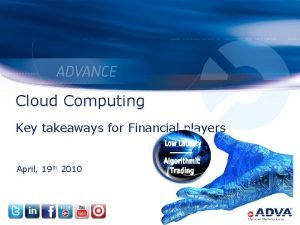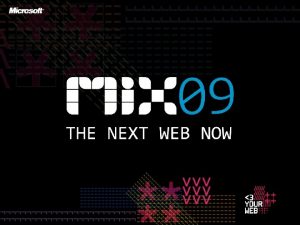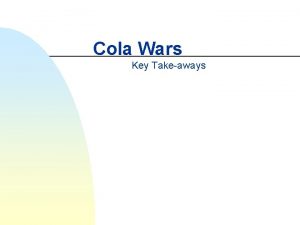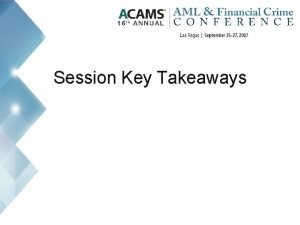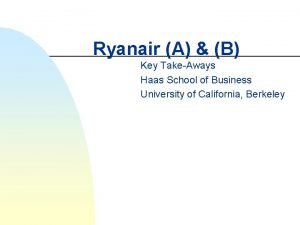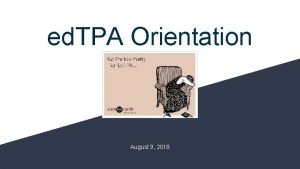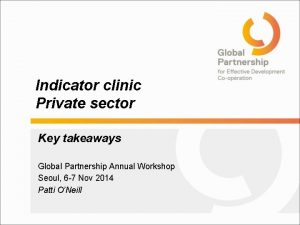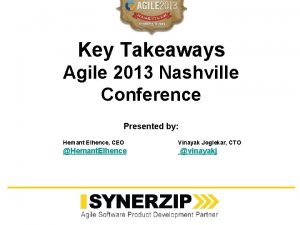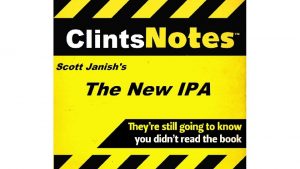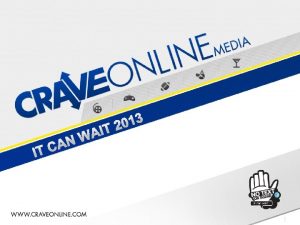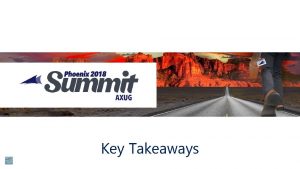Module 22 Key Takeaways Section 1 Introduction to








































- Slides: 40

Module 22: Key Takeaways


Section 1 Introduction to the ACA and Your Role Review Module 1: Introduction to the ACA and Your Role Module 2: Understanding the Marketplace Module 3: Privacy and Security

Goals of the ACA Module 1: Intro to the ACA and Your Role GOAL #1: Increase access to health care coverage for all Americans • Creation of Health Plan Marketplaces GOAL #2: Introduce new protections for people who already have health insurance • • Essential Health Benefits Denying Coverage for Pre-Existing Conditions Prohibited Discrimination Prohibited Annual and Lifetime Dollar Amounts Eliminated New Protections

Insurance Requirements Module 1: Intro to the ACA and Your Role • No insurance = federal tax penalty • Plans must meet “minimum essential coverage” • Exemptions are available for certain individuals • It is not illegal to not have health insurance, just have to pay federal penalty

Marketplace Terms Module 2: Understanding the NY State of Health Federal Poverty Level (FPL)

Process for Assisting Consumers Module 2: Understanding the NY State of Health 1. Assistor Engages Consumer 2. Assistor Helps Consumer Open an Online Account 3. Assistor Helps Consumer Complete the Individual Application 4. Assistor Helps Consumer Submit Application for Marketplace Eligibility Determination 5. Assistor Helps Consumer Review Options and Consumer Selects Health Plan

Privacy and Security Terms Module 3: Privacy and Security • Health Insurance Portability and Accountability Act (HIPAA) • Personally Identifiable Information (PII) • Protected Health Information (PHI) You are a business associate and it is your responsibility to protect PII and PHI.

Domestic Violence Module 3: Privacy and Security Controlling access to information is a type of domestic violence Provide contact information for domestic violence hotlines

Privacy and Security Rules Module 3: Privacy and Security Privacy Rule Requires the protection of PHI/PII Security Rule Safeguards to ensure the confidentiality, integrity and availability of PHI/PII

Assistor Privacy and Security Responsibilities Module 3: Privacy and Security It is important to: • Protect your workstation NEVER discuss PII/PHI: • With co-workers who do • Lock your workstation • Secure any written PII/PHI not “need to know” • Protect user IDs/passwords • Via telephone • Use anti-virus software • With a non-authorized • Never let anyone else use person your account • Transmit PII / PHI via non- • Minimize storage of PII/PHI • Never transmit PII/PHI via non encrypted email -encrypted e-mail If you do not protect PII and PHI there are consequences

Section 2 Types of Health Insurance Review Module 4: Public Insurance Programs Module 5: Essential Plan Module 6: Commercial Insurance Programs Module 7: Federal Subsidies

Types of Insurance Module 4: Public Insurance Programs

Public Insurance Programs Module 4: Public Insurance Programs Medicaid monthly cost nimal co-pays, if applicable time in the year S Child Features Cost -No or Low mo -No monthly co Indian/Alaskan 400% FPL -Monthly Fami children) -No cost sharin Enrollment Period Any time in the Coverage -12 months con -Coverage is pr months continuous coverage n request retroactive coverage up to 3 months dicaid Emergency: Coverage for Emergency dical Condition only dicaid Emergency: No Yes Eligibility Criteria US Citizen/Lawfully Residing No

Essential Plan Module 5: Essential Plan Features Cost -No monthly cost, < or = 150% FPL -$20 premium, per individual, per month, > 150% FPL -Higher premium for optional plans with Dental and Vision, > 138% FPL -No monthly cost for American Indian/Alaskan Natives, unless they pick a plan with optional Dental and Vision -No deductible and minimal co-pays, if applicable Enrollment Period Any time in the year -Grace period for payment (30 days) -Coverage begins on 1 st of the month of enrollment for < or = 138% -Coverage is prospective for >138% FPL (following “ 15 th of the month” rule) Coverage -Comprehensive package of items and services (EHBs) -Depending on eligibility, some individuals will have additional benefits -Vision and dental included for individuals < or = 138% FPL at no extra cost; available at an extra cost for individuals >138% FPL -Free preventive care Eligibility Criteria US Citizen/Lawfully Present Resident Requirement? Yes NYS Resident Requirement? Yes Income -Greater than 138% FPL and less than or equal to 200% FPL -Less than 138% FPL and eligible for state-only Medicaid due to immigration status Additional Factors -Below 65 at beginning of plan year -Not eligible for Medicaid or Child Health Plus -Not eligible for MEC -Will not be eligible to receive PTCs -Pregnant women are eligible for Medicaid if their income is up to 223% FPL

Commercial Insurance Programs Module 6: Commercial Insurance Programs Qualified Health Plan (QHP) Features COMMERCIAL INSURANCE TERMS - RESOURCE Cost Metal levels Enrollment Period -Open enrollment period Nov 1 – Jan 31 -Special Enrollment Period (SEP) -Grace period for payment (10 days 1 st month, 30 days every month after) Coverage -Essential Health Benefits -Follows limits on out-of-pocket expenses -Standard or non-standard Eligibility Criteria US Citizen/Lawfully Residing Yes

Federal Subsidies Module 7: Federal Subsidies Premium Tax Credit (PTC) Cost Sharing Reduction (CSR) Features What does it do? -Subsidizes QHP premium costs -Subsidizes QHP cost-sharing (copay, deductible, coinsurance) Enrollment Period -Open enrollment period Nov 1 – Jan 31 -SEP -Grace period for payment (10 days 1 st month, 90 days every month after) Applies to which Metal Level -All Metal Level Plans? -Cannot be applied to catastrophic -Silver Plans only

Section 3 Assistor Skill Building Review Module 8: Assistor Requirements Module 9: Communication Module 10: Cultural Competency

Assistor Goals Module 8: Assistor Requirements EDUCATE consumers on the Affordable Care Act (ACA) and the Marketplace ASSIST consumers with completing their Marketplace application

Assistor Requirements Module 8: Assistor Requirements Meet Certification Requirements No conflicts of interest Comply with privacy Ensure consumers receive services in & security standards their preferred language Provide assistance in a neutral, non-biased way Provide service in an accessible way to consumers with disabilities

Communication Skills Module 9: Communication 1. Before meeting consumers • Consider physical proximity to consumers • Get organized • Consider disability accessibility 2. Upon meeting consumers • Use appropriate body language and eye contact • Use friendly greetings and consumers’ names • Smile • Be polite 3. Throughout meeting with consumers • Frame the meeting (why you must ask questions and confidentiality) • Use closed and openended questions • Paraphrase • Display empathy • Control your emotions • Ask if consumer has questions

How to be Culturally Competent Module 10: Cultural Competency 2. Understand your own culture 1. Acknowledge and value cultural differences 3. Engage in self-assessment 5. View behavior in a cultural context 4. Acquire cultural knowledge and skills Source: 2013 – National Center for Cultural Competence. Excerpt from Cross, T. L. , Bazron, B. J. Dennis, K. W. , Issacs, M. R. & Benjamin M. P. Towards A Culturally Competent System of Care, (Vol. 1). Washington, DC. (1989).

Section 4. Completing the Marketplace Application Review Module 12: Identity Proofing Module 13: Household Size Module 14: Household Income Module 15: Additional Information and Eligibility Determination Module 16: Documentation Requirements Module 17: Application Practice

Application Process Module 12: Identity Proofing • High level data check that verifies the identity of the account creator • Account holder will need to enter: • Name • Gender Step 1: • Date of Birth Identity • Social Security Number, if they have one Proofing • When SSN is not required to obtain coverage: • Child Health Plus • Emergency Medicaid • PRUCOL • Pregnant Women • If consumer cannot be identity proofed, Assistor can follow a few steps to troubleshoot

Application Process Module 13: Household Size • Income and family size help determine what programs the consumer qualifies for Step 2: • Consumers should tell us about everyone in their family or Household who lives at their house Size • In general, household is based on tax filing household – There are certain tax dependents whose individual household size is determined according to non-filer rules • Additional questions about each household member

Application Process Module 14: Household Income • Consumers must enter information based on their anticipated tax status • Consumers who enroll in a QHP with PTC and/or CSR Step 3: must attest to filing taxes in the upcoming year Household Income • Consumers applying for Medicaid, Child Health Plus or a Full Pay QHP do not have to attest to filing taxes • Assistors should counsel consumers to report ALL income, regardless of source • Certain types of income will not count in the eligibility determination process

Application Process Module 15: Additional Information, Eligibility Determination and Duration of Enrollment • Additional Information section will ask consumer up to 4 key questions: – Absent Parent – Other insurance Step 4: Step 5: – Residency Status Additional Eligibility – Incarceration Information Determination • Duration of Enrollment and Renewal – Renewal is required to maintain eligibility – Time period for renewal will depend on program consumers are enrolled in

Application Process Module 15: Additional Information and Eligibility Determination Step 5: Eligibility Determination • Address change, income, birth of a child, marriage, divorce • Consumers can update information in person, online or by phone • Medicaid and Child Health Plus include 12 months of continuous coverage

Application Process Module 16: Documentation Requirements

Section 5 Choosing a Plan Review Module 19: Choosing a Plan

Choosing a Plan Module 19: Choosing a Plan Step 1: Help consumer identify priorities Step 2: Help consumer use Marketplace tools to narrow down plan options Step 3: Help consumer select plan WANTS/NEEDS QUESTIONS AND PRIORITIES WORKSHEET- RESOURCES

Choosing a Plan Module 19: Choosing a Plan It is not possible to accurately tell consumers how much a plan will cost them over the year o This will depend on how many services and medications they use in the plan year • Don’t tell them what the “cheapest plan” is—there is no guaranteed “cheapest plan” • Consumers may only be considering premium costs; be sure they understand the importance of the deductible and other out-of-pocket costs •

QHP Plan Name Format Module 19: Choosing a Plan

Essential Plan Name Format • Four Essential Plan variations – Essential Plan 1: Premium = $20/month (higher if selecting a plan – with Dental and Vision) Essential Plan 2: Premium = $0 (unless they select a plan with Dental and Vision) Essential Plans 3 and 4: Premium = $0 – • The Marketplace name format allows you to see: Field Name Values Meaning Product Name To be assigned by insurer Essential Plan Level EP 1, EP 2, EP 3 or EP 4 Identifies EP level Dental and Vision coverage Adult Dental/Vision Identifies type of Adult Dental and Vision coverage, if any

Section 6 Closing Review Module 20: Complaints and Appeals Module 21: Assistor Registration and Resources

Complaints and Appeals Module 20: Complaints and Appeals • Complaint – Consumer participating in the Marketplace feels the service they received was unsatisfactory • Appeal – Consumer participating in the Marketplace does not agree with eligibility determination, policy or other activity related to health insurance coverage

Complaints and Appeals Processes Module 20: Complaints and Appeals • Complaint Process – Use your customer service skills – Send complaints to your supervisor – If required, tell consumer to contact the Customer Service Center • Appeal Process – Help consumers understand how they can apply for appeals and next steps – Can help consumers file appeals – Cannot make the decision to file an appeal or represent the consumer during the appeal process

Assistor Registration Process Module 21: Assistor Registration and Resources

Customer Service Center Module 21: Assistor Registration and Resources • 1 -855 -355 -5777 • Identify yourself as an Assistor o First and last name o Assistor Account (AC) Number and Assistor Phone Number OR; o Assistor SSN, Assistor DOB and Assistor Phone Number

Module Recap
 Key takeaways powerpoint template
Key takeaways powerpoint template Mathsbot differentiated questions
Mathsbot differentiated questions Jacques van takeaways
Jacques van takeaways Module 00104 introduction to power tools
Module 00104 introduction to power tools C device module module 1
C device module module 1 Chapter 10 section 1 meiosis
Chapter 10 section 1 meiosis Section 28-2 groups of arthropods answer key
Section 28-2 groups of arthropods answer key Introduction of arthropods
Introduction of arthropods Section 1 introduction to protists answer key
Section 1 introduction to protists answer key Section 22-1 introduction to plants
Section 22-1 introduction to plants Business model sample
Business model sample Key partners key activities key resources
Key partners key activities key resources Learning: module 2: section 19_03-19_05
Learning: module 2: section 19_03-19_05 Learning: module 4: section 16_07-16_08
Learning: module 4: section 16_07-16_08 Module 00105-15 introduction to construction drawings
Module 00105-15 introduction to construction drawings Module 00105
Module 00105 Operations management module
Operations management module Module 70 introduction to therapy
Module 70 introduction to therapy Core module 3 introduction to hand tools
Core module 3 introduction to hand tools 00102 15 introduction to construction math
00102 15 introduction to construction math An engineer's scale is set up in multiples of
An engineer's scale is set up in multiples of Module 1 introduction to food safety
Module 1 introduction to food safety Introduction to mice
Introduction to mice Module 3 introduction to hand tools test
Module 3 introduction to hand tools test Cross contamination examples
Cross contamination examples Struck or hammered tools
Struck or hammered tools Introduction to entrepreneurship module pdf
Introduction to entrepreneurship module pdf Module 5 supply and demand introduction and demand
Module 5 supply and demand introduction and demand Module 3 exam introduction to hand tools answers
Module 3 exam introduction to hand tools answers 00104-15 introduction to power tools
00104-15 introduction to power tools Emc
Emc Nccer introduction to hand tools
Nccer introduction to hand tools Grade 9 english module
Grade 9 english module Principles of marketing quarter 2 -- module 7
Principles of marketing quarter 2 -- module 7 Principles of marketing quarter 1 module 6
Principles of marketing quarter 1 module 6 Principles of marketing module 2 relationship marketing
Principles of marketing module 2 relationship marketing Module 4: investing test answer key
Module 4: investing test answer key Icici learning matrix
Icici learning matrix Module 16 arc length and sector area
Module 16 arc length and sector area Business math module 3
Business math module 3 Propane module 7 answer key
Propane module 7 answer key
